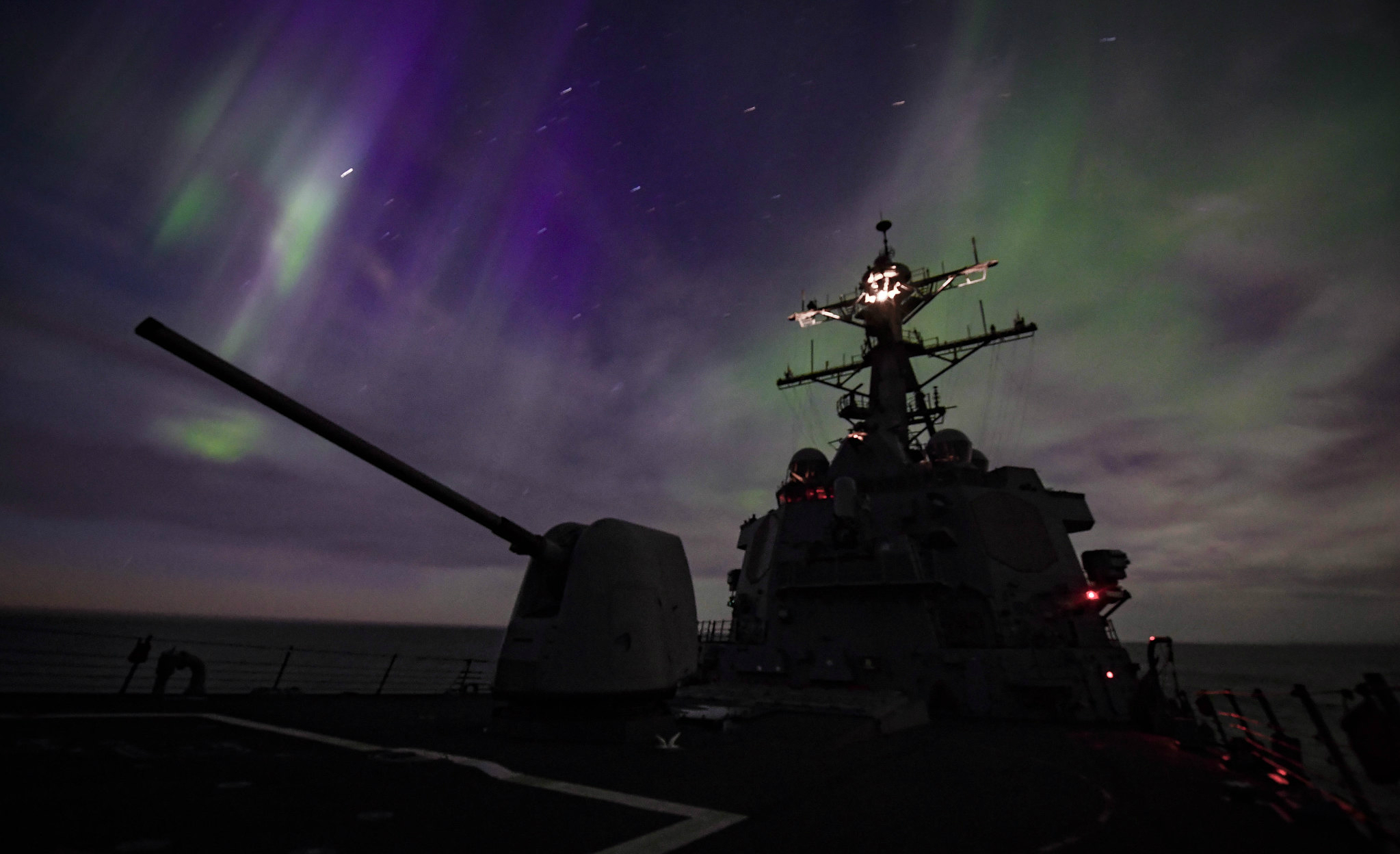The U.S. Navy ups its Arctic engagement, sending ships north and establishing a temporary presence in Iceland
Four guided-missile ships (a cruiser and three destroyers) from the newly reactivated 2nd Fleet have set up a temporary base in Keflavik.

The U.S. Navy continues to step up its Arctic engagement, sending one cruiser and three destroyers into North Atlantic waters, and establishing a temporary command presence in Iceland as part of an expeditionary mission in the region. Two of those ships sailed north of the Arctic Circle as part of that mission, the Navy said.
[How geopolitics complicate the U.S. Navy’s plans for major Arctic operations]
The four vessels, the Ticonderoga-class guided-missile cruiser USS Normandy and Arleigh Burke-class guided-missile destroyers USS Lassen, USS Forrest Sherman, and USS Farragut and a helicopter maritime strike squadron are part of the newly-reactivated U.S. 2nd Fleet intended to counter Russian activity in the Arctic and North Atlantic. The vessels sailed from their home base in Mayport, Florida earlier this month and on arrival formed a Surface Action Group. As the 2nd Fleet does not have any permanent operations center in Europe, around 30 of its staff set up a temporary Maritime Operations Center in Keflavik, Iceland, which will coordinate the SAG’s activity.
The move comes after last year saw the nuclear aircraft carrier USS Truman and its support ships venture into the region as part of NATO’s Trident Juncture exercise — the first U.S. carrier to do so in nearly 30 years.
Countering Russian influence
Arctic and military experts have long emphasized the need for a greater U.S. presence to counter Russia’s growing military activity in the region. Increasingly sharp rhetoric by U.S. officials criticizing Russian and Chinese activity in the region, including Secretary of State Mike Pompeo at the Arctic Council earlier this year, stood in contrast to the U.S. military’s lack of capability and experience in the High North. This latest military exercise may yet be a sign that the U.S. intends to take a more active role in the region.
“These deployments add force to the speech made by Secretary Pompeo in Finland earlier this year. It shows an American military increasingly waking up to the need to maintain a presence in the Arctic. It’s long past-time for this,” explains Andrew Holland, Chief Operating Office of the American Security Project, a U.S. security-focused think tank.
[The US Navy’s new Arctic strategy is limited in scope and details, say critics]
U.S Navy Rear Admiral David Titley (ret.) voices a similar sentiment in comments made to High North News:
“These actions do give me some reason for cautious optimism that — whatever internal Navy and DoD dynamics are playing out — there must be some senior officials who understand that, like it or not, the Arctic is going to become an increasingly strategic waterway in the years and decades ahead.“
Gaining Arctic experience
The U.S. Navy has a wealth of operational experience running submarines under the Arctic Ocean’s ice and conducts biennial exercises called ICEX. The environment for surface vessels, however, is completely different emphasizes Capt. Chris Slattery, the director of 2nd Fleet’s MOC in Iceland.
“Successful operations in the Arctic require practice, and we will take the lessons learned from this deployment to further refine the expeditionary Maritime Operations Center concept for future operations in the North Atlantic and Arctic regions,” explains Capt. Slattery.
The U.S. Navy has limited support infrastructure in the Arctic requiring careful logistical planning for resupplies and medical support. “If you look at the map of the Arctic…and you look at what we have for supportability in the Arctic…it’s not much,” Capt. Slattery said.
Operating in Arctic waters involves technological challenges such as the region’s particular navigational and communications requirements but can also be as basic as dangerous ice buildup on vessels which sailors battle with baseball bats.
“Iceland is a key ally, and its strategic location in the North Atlantic provides a perfect opportunity to test out our expeditionary MOC for the first time,” confirmed Vice Adm. Andrew Lewis, the commander of 2nd Fleet. “Operating out of Iceland reinforces our partnership while allowing us to practice operating in an expeditionary manner and test our ability to surge forward.”
From policies to increased presence
The U.S. Navy released its Arctic Strategic Outlook earlier this year. Many experts found the document short on details about how the U.S. wanted to step up its presence in the region and doubted that the U.S. Navy was really interested in committing surface forces to the Arctic or financing the development of ice-capable vessels to shore up its presence in the region.
And while the Navy continues to depend on the U.S. Coast Guard when it comes to providing ice-breaking capability, it has nonetheless explored options how its vessels can operate in increasingly lighter ice conditions. New research by the Naval Sea Systems Command (NAVSEA), a kind-of engineering division of the Navy, indicates that Burke-class destroyers — the type that is currently operating around Iceland — could be upgraded to operate in light ice conditions.
The destroyer’s engine power is sufficient to navigate through up to 0.8 meters of ice, while its current hull design makes it suitable to pass through up to 0.3 meters of ice. Hull reinforcements would further augment that capability and upgrades to the heating and air conditioning system and a de-icing system could turn the destroyers into ice-hardened ships, the research confirms.
CORRECTION: An earlier version of this story mistakenly reported that U.S. Naval vessels sailed to Iceland. Rather, the ships sailed into North Atlantic waters, and in some cases Arctic waters, while working with a temporary command presence based in Iceland. This article and its headline have been updated to reflect this.